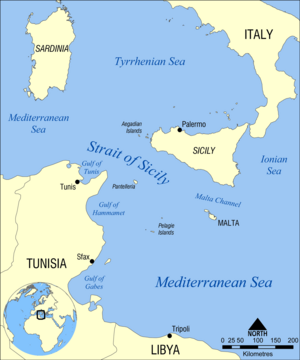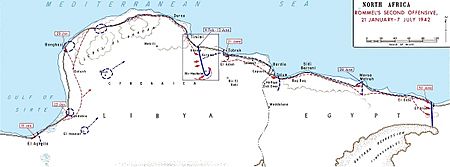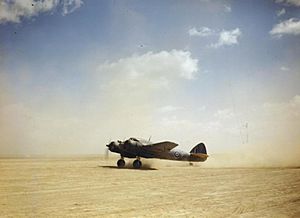Operation Harpoon (1942) facts for kids
Quick facts for kids Operation Harpoon/The Battle of Pantelleria |
|||||||
|---|---|---|---|---|---|---|---|
| Part of the Battle of the Mediterranean of the Second World War | |||||||
 The burning wreckage of the tanker Kentucky and the freighter Burdwan seen at the end of the battle from the deck of the cruiser Raimondo Montecuccoli |
|||||||
|
|||||||
| Belligerents | |||||||
| Commanders and leaders | |||||||
| Alban Curteis Cecil Hardy |
Alberto da Zara | ||||||
| Strength | |||||||
| 2 aircraft carriers 1 battleship 4 light cruisers 1 minelayer 17 destroyers 4 minesweepers 6 motor launches 6 merchant ships |
2 light cruisers 5 destroyers aircraft |
||||||
| Casualties and losses | |||||||
| 2 destroyers sunk 4 merchant ships sunk 2 light cruisers damaged 3 destroyers damaged 1 minesweeper damaged 1 merchant ship damaged 101+ personnel killed 20+ wounded 217 (POW) |
1 destroyer damaged 29 aircraft destroyed 12 killed |
||||||
Operation Harpoon was a major naval battle during World War II. It was one of two important convoys (groups of supply ships) sent by the Allies to deliver much-needed supplies to the island of Malta in June 1942. Malta was a British base in the Mediterranean Sea and was constantly under attack by Axis (German and Italian) forces.
Operation Harpoon sailed from Gibraltar in the west, while another convoy, Operation Vigorous, came from Alexandria in the east. Only two of the six supply ships in the Harpoon convoy made it to Malta. Many Allied warships were lost or damaged in the process. The Axis powers knew about these convoys because their intelligence had managed to break some Allied codes.
Contents
Why Malta Needed Supplies
The Siege of Malta in 1942
In 1942, Malta was under a very heavy attack, known as a siege. Axis planes bombed the island almost constantly. They targeted docks, ships, planes, and airfields. By April 1942, Malta's defenses were badly damaged. The bombing then shifted to places like camps and warehouses, preparing for a possible invasion.
The constant bombing meant Malta was running very low on food and other important supplies. An earlier convoy in March had tried to bring supplies, but most of its ships were sunk. Only about 5,000 tons of supplies were unloaded. This was not enough.
Food rations were cut even more. People had less meat, fats, and sugar. The daily bread ration was reduced to a very small amount. Many ships in Malta's harbor were sunk or damaged. This made it hard for Malta to be used as a base for attacking enemy ships.
Axis Plans to Invade Malta
The Axis powers had a secret plan called Unternehmen Herkules (Operation Hercules) to invade Malta. They sent many German planes to Sicily, which is close to Malta. The heavy bombing of Malta made the British think an invasion was coming.
However, the invasion never happened. German leader Adolf Hitler was not very keen on the idea. He worried that the Italian navy might not be able to support the German paratroopers (soldiers who jump from planes). Also, when the Axis captured the city of Tobruk in North Africa in June, they decided to focus on chasing the British army into Egypt instead. This meant Operation Hercules was cancelled.
Fighting in the Desert
Meanwhile, in North Africa, the British and Axis armies were fighting in the desert. The British army, called the Eighth Army, had advanced far into Libya. This allowed them to use airfields closer to Malta, which helped protect supply convoys.
But the Axis forces, led by General Erwin Rommel, attacked first. The British were pushed back. They lost control of important airfields in Libya. This made it much harder for British planes to provide air cover for convoys heading to Malta.
Getting Ready for the Convoy
Operation Julius: Preparing for the Convoys
About two weeks before Operation Harpoon, the British sent more Spitfire fighter planes to Malta. This increased the number of working fighter planes to 95. This was very important for defending the island.
Planes from Gibraltar, Malta, and Egypt started flying reconnaissance missions. They were looking for the Italian fleet. Different types of bombers and fighter planes were made ready. Short-range fighters would protect the convoy at first. Then, longer-range fighters would take over as the convoy moved.
Operation Vigorous: The Other Convoy
Operation Vigorous was the other convoy sailing to Malta at the same time. It was a joint effort by the British Navy and Air Force. The plan was for the convoy to be protected by many warships. If a large Italian force attacked, the British ships would use smoke to hide the convoy and torpedoes to fight back. The success of this convoy also depended on air and submarine attacks weakening the Italian fleet before it could get close.
The Convoy's Journey
June 12: Setting Sail
The Harpoon convoy, called MW4, left Gibraltar on June 12, 1942. It had six merchant ships carrying about 43,000 tons of cargo and oil. These ships were the British Troilus, Burdwan, and Orari, the Dutch Tanimbar, the American Chant, and the tanker Kentucky.
The convoy was protected by a group of warships called Force X. This included the anti-aircraft cruiser HMS Cairo, nine destroyers, and a fast minelayer called HMS Welshman. A larger group of warships, Force W, provided distant protection. This group included the battleship HMS Malaya, two aircraft carriers (Argus and Eagle), and several cruisers and destroyers. The aircraft carriers carried fighter planes like Sea Hurricanes and Fulmars, and torpedo planes like Swordfish.
June 14: First Attacks
Early on June 14, an Italian submarine tried to attack the convoy. Later that morning, an Italian plane spotted the convoy near Sardinia. British fighters shot it down before it could report. However, another Italian plane saw the convoy later. This area was heavily defended by Italian bombers and fighters, more than the British expected.
Italian torpedo bombers attacked first. They sank the supply ship Tanimbar. The British cruiser Liverpool was damaged and had to be towed back to Gibraltar. Later that day, the main covering force returned to Gibraltar. The fast minelayer Welshman went ahead alone to Malta, delivered ammunition, and then sailed back to rejoin the convoy.
June 15: The Main Battle
At dawn on June 15, near the island of Pantelleria, the convoy faced a big attack. Axis planes attacked, and then Italian warships appeared. The Italian force included two light cruisers, Raimondo Montecuccoli and Eugenio di Savoia, and five destroyers.
The British destroyers in the convoy escort laid down a smokescreen to hide the supply ships. They also attacked the Italian squadron. But two British destroyers, HMS Bedouin and Partridge, were hit many times by the Italian cruisers and stopped moving. The cruiser Cairo was also hit.
The Italian destroyers got very close to the supply ships and hit one of them. One Italian destroyer, Vivaldi, was hit by British gunfire and caught fire, but it was saved. Both sides stopped fighting for a while, and the Italians lost track of the convoy.
Later, the Italian cruisers returned. They found the tanker Kentucky and the freighter Burdwan, which had already been damaged by air attacks and abandoned. The Italian ships sank both of them. The ship Chant had already been sunk by bombing.
The British destroyer Partridge tried to tow the damaged Bedouin, but the Italian cruisers came back again. Partridge had to leave Bedouin behind and escape to Gibraltar. Bedouin was badly damaged and eventually sank after being hit by an aerial torpedo from an Italian bomber. Many of its crew were killed, and over 200 were rescued and taken prisoner by the Italians.
Later that evening, the remaining British ships ran into a minefield near Malta. The destroyers Badsworth and Matchless and the supply ship Orari hit mines and were damaged. The Polish destroyer ORP Kujawiak sank.
Of the six original supply ships, only two, Orari and Troilus, reached Malta. Orari lost some of its cargo due to a mine explosion. The minesweeper HMS Hebe also hit a mine and was badly damaged.
After the Battle
Losses
The battle was a victory for the Axis forces. The British and Polish forces suffered many losses.
- On HMS Bedouin, 28 crew members were killed.
- On HMS Liverpool, 15 were killed.
- On ORP Kujawiak, 13 were killed.
- On HMS Badsworth, 9 were killed.
- On HMS Cairo, 2 were killed.
- On HMS Partridge, 1 was killed.
- On the auxiliary minesweeper Justified, 3 were killed.
- On the supply ships, 23 were killed on Tanimbar, 4 on Chant, and 3 on Burdwan.
In total, over 100 Allied personnel were killed, and 217 were taken prisoner. The Italian hospital ship Meta rescued many survivors from the sunken ships.
The Axis forces had fewer losses. One Italian destroyer was damaged, and 29 aircraft were destroyed. Twelve Axis personnel were killed.
Ships Involved
- Key: † sunk, # damaged, ## badly damaged.
Allied Forces
- Supply Ships: Burdwan†, Chant†, Orari ##, Tanimbar†, Troilus, Kentucky† (tanker)
- Covering Force (Force W):
* Battleship: HMS Malaya * Aircraft Carriers: HMS Eagle, Argus (carrying Sea Hurricanes, Fulmars, Swordfish) * Light Cruisers: HMS Kenya, Liverpool ##, Charybdis * Destroyers: Many destroyers from the 17th and 13th Destroyer Flotillas.
- Convoy Escort (Force X):
* Light Cruiser (Anti-Aircraft): HMS Cairo # * Destroyers: HMS Bedouin†, Marne, Matchless ##, Ithuriel, Partridge #, HMS Blankney, Badsworth ##, Middleton, ORP Kujawiak† * Minesweepers: HMS Hebe ##, Speedy, Rye, Hythe * Minelayer: HMS Welshman
- 7th Cruiser Division:
* Light Cruisers: Eugenio di Savoia, Raimondo Montecuccoli * Destroyers: Ascari, Alfredo Oriani, Premuda, Ugolino Vivaldi ##, Lanzerotto Malocello
Images for kids
See also










